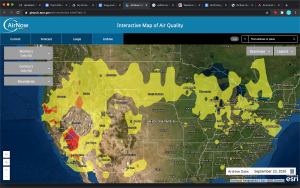California Wildfires and National Air Quality
By Meera Shroff, Bethesda Green Environmental Leader
Thousands of miles away, wildfires burn on the West Coast. Yet in mid-September, people who looked upwards in D.C. and Maryland saw hazy skies. The California wildfires caused massive damage to the environment and people on the West Coast. Although their strongest effects are limited to the local area, those wildfires cause damage to global air quality. Residents can take steps to help reduce the negative effects of the California wildfires and prevent local wildfires.
Wildfires release plumes of smoke containing pollutants that dramatically worsen air quality; in fact, West Coast air quality conditions during the wildfires were “among some of the worst ever recorded,” according to Associated Press News. This poor air quality might seem unrelated to Bethesda, due to its location on the opposite coast. However, atmospheric jet streams — quickly flowing air currents with extremely high velocities — carry pollutants, like those found in smoke plumes, across the country and world. California’s plumes of smoke even reached Canada, Mexico, and northern Europe. The smoke caused the yellow-tinged sky some locals saw in September.
On the EPA’s air quality tracker, a band of worsened air quality appears to stretch between the coasts on September 23: from Southern California up towards South Dakota and down to Washington, D.C. In the first week of October, the air quality worsens and spreads first along the West Coast. Then, by October 7, the air quality drops on some areas of the southern East Coast. Extremely poor air quality conditions are dangerous, especially for young children, older adults, and people with preexisting conditions. Poor air quality can cause a decline in lung function that leads to bronchitis and pneumonia, as well as itchy eyes, itchy throats, and exacerbation of asthma. The pollutants of fresh smoke have been linked to death, although exactly how is unknown.
Thankfully for people on the East Coast, the pollutants’ health effects are reduced from farther away, and should not pose a significant risk to residents. However, the wildfires release carbon dioxide, black carbon (part of soot), brown carbon (light-absorbing carbon) and small particles into the atmosphere. These act like greenhouse gases, trapping in heat and worsening climate change.
Wildfires on the West Coast are better-known and featured more in the news, but there are wildfires in Maryland. According to Maryland’s Department of Natural Resources, on average, there are 325 wildfires per year. In Maryland, human activity causes 96% of wildfires. The two biggest causes are improper burning of debris and arson, which together account for 51% of the fires started. Most burn less than 10 acres; however, small wildfires can still damage residential areas and wildlife habitats.
Maryland residents can take many steps to prevent local wildfires. If you live near a woodland or in a woodland, you can create a safety zone around your house to prepare for a wildfire and minimize damage. This zone should be 30 feet in area and should not have any dead leaves and other debris, which are particularly flammable. Plants should be at least 4 feet from the house. In case of a fire, emergency responders may need to access your house, so make sure the address is clearly visible at all times of day and your driveway is clear of vegetation.
During the spring and the fall, conditions in Maryland are ripe for fires. Leaves fall off trees, giving sunlight and wind access to the ground, making ground debris drier and more flammable. The humidity is typically lower during these seasons than in summer, further drying out debris. People who burn leaves during a day in the fall or spring should be especially careful and monitor the fire closely. Follow regulations when practicing open air burning. Have a gap of at least 10 feet around the material being burned, keep water and equipment nearby in case the fire escapes, and do not burn on a particularly dry or windy day. When you are done, make sure to extinguish all fires completely. These steps will help prevent local fires, but far-away fires can still pose an air quality risk. During a situation where air quality is dangerous, people who may be sensitive to air quality conditions should stay inside to avoid pollutants.
The California wildfires worsen climate change and there are many steps you can take to reduce climate change more generally. California is currently experiencing a drought, which worsens the wildfires. By buying locally, instead of from California, you may reduce the amount of water needed for agriculture. For more information, check out different organizations such as the California Department of Forestry and Fire Protection website. The California wildfires have negative ramifications for the whole country and the whole world. Local wildfires damage our environment and worsen our air quality. No matter where we live, we have an imperative to work towards reducing the effects of wildfires to help protect people’s health and prevent climate change.
References
Baker, M. (2020, September 15). Some of the Planet’s Most Polluted Skies Are Now Over the West Coast. The New York Times. https://www.nytimes.com/2020/09/15/us/fires-california-oregon-washington-west.html.
Black carbon. Climate & Clean Air Coalition. https://www.ccacoalition.org/en/slcps/black-carbon.
Bryan, S. M. (2020, September 17). Western Wildfire Smoke Causes East Coast Haze, Vivid Sunsets. Associated Press News. https://apnews.com/article/wildfires-new-york-city-mexico-new-york-europe-f36aead1c4117fb54f2b821bcb29ee8a.
California Department of Forestry and Fire Protection (CAL FIRE). About Us. Cal Fire Department of Forestry and Fire Protection. https://www.fire.ca.gov/about-us/.
Environmental Protection Agency. AirNow Interactive Map of Air Quality . EPA. https://gispub.epa.gov/airnow/index.html?tab=3.
Feng, Y. Brown Carbon Aerosols. Environmental Science Division (EVS) Predictive Environmental Understanding. https://www.evs.anl.gov/research-areas/highlights/brown-carbon.cfm.
Firewise Living in Maryland. Maryland Department of Natural Resources. https://dnr.maryland.gov/forests/Pages/fire/firewise.aspx.
Fletcher, L. (2020, September 9). US wildfires are not reserved for for the West, and there are overlooked risks in the East. ABC 7 WJLA. https://wjla.com/features/7-on-your-side/wild-fires-dc-virginia-maryland-forest-service-budget.
Livingston, I. (2020, September 15). Smoke in D.C.’s skies traveled thousands of miles from the West Coast. The Washington Post. https://www.washingtonpost.com/weather/2020/09/15/wildfire-smoke-dc-maryland-virginia/.
Mcdermott, M. (2020, September 18). How to Help Victims of the California Wildfires. The New York Times. https://www.nytimes.com/2020/09/18/us/help-wildfires-victims.html. Updated 16 October 2020.
Northern California Wildfire Relief Resource Page. California Community Foundation. (2020, October 12). https://www.calfund.org/norcal-wildfire-relief/.
Pfeiffer, S., & Fischer, E. (2020, September 18). Smoke From Wildfires Reaches East Coast And Europe. What Are Its Effects? NPR. https://www.npr.org/2020/09/18/914519490/smoke-from-wildfires-reaches-east-coast-and-europe-what-are-its-effects.
Quality of Air Monthly Reports. Maryland Department of the Environment. https://mde.state.md.us/programs/Air/AirQualityMonitoring/Pages/AQSummary.aspx.
Rutgers-Newark Scientist Explains Effects of Wildfires on East Coast Air Quality. Insider NJ. (2020, September 28). https://www.insidernj.com/press-release/rutgers-newark-scientist-explains-effects-wildfires-east-coast-air-quality/.
Wildland Fire in Maryland. Maryland Department of Natural Resources. https://dnr.maryland.gov/forests/Pages/wfm.aspx.
Current Air Quality Conditions. Maryland Department of the Environment. https://mde.state.md.us/PROGRAMS/AIR/AIRQUALITYMONITORING/Pages/index.aspx.
About the author:
 Meera Shroff, Bethesda Green Environmental Leader
Meera Shroff, Bethesda Green Environmental Leader
Meera is a Walt Whitman High School Senior. She is committed to combating the broad, daunting issue of climate change and its environmental repercussions. She believes working locally is essential to protecting the earth and build a better future.







